Heavy Metal Pollution in Sediments of the Yu River in a Polymetallic Ore Concentration Area: Temporal–Spatial Variation, Risk Assessment, and Sources Apportionment
Abstract
1. Introduction
2. Materials and Methods
2.1. Study Area and Sampling
2.2. Chemical Analysis
2.3. Accumulation Risk Assessment for Heavy Metals in the Soil
2.4. Assessment of Potential Ecological Risk
2.5. Multivariate Statistical Analysis
3. Results
3.1. Characteristics of Heavy Metals in Sediments
3.2. Environmental Risk Assessment
4. Discussion
4.1. Temporal–Spatial Variations and Migration of Heavy Metals in Sediments
4.2. Source Apportionment of Heavy Metals in Sediments
5. Conclusions
Supplementary Materials
Author Contributions
Funding
Institutional Review Board Statement
Informed Consent Statement
Data Availability Statement
Conflicts of Interest
References
- Usman, Q.A.; Muhammad, S.; Ali, W.; Yousaf, S.; Jadoon, I.A.K. Spatial distribution and provenance of heavy metal contamination in the sediments of the Indus River and its tributaries, North Pakistan: Evaluation of pollution and potential risks. Environ. Technol. Innov. 2021, 21, 101184. [Google Scholar] [CrossRef]
- Nguyen, B.T.; Do, D.D.; Nguyen, T.X.; Nguyen, V.N.; Phuc Nguyen, D.T.; Nguyen, M.H.; Thi Truong, H.T.; Dong, H.P.; Le, A.H.; Bach, Q.-V. Seasonal, spatial variation, and pollution sources of heavy metals in the sediment of the Saigon River, Vietnam. Environ. Pollut. 2020, 256, 113412. [Google Scholar] [CrossRef] [PubMed]
- Pavlychenko, A.; Kovalenko, A.; Pivnyak, G.; Bondarenko, V.; Kovalevs’ka, I.; Illiashov, M.K. The investigation of rock dumps influence to the levels of heavy metals contamination of soil. Min. Miner. Depos. 2013, 237, 238. [Google Scholar]
- Algül, F.; Beyhan, M. Concentrations and sources of heavy metals in shallow sediments in Lake Bafa, Turkey. Sci. Rep. 2020, 10, 11782. [Google Scholar] [CrossRef] [PubMed]
- Tang, J.; He, M.; Luo, Q.; Adeel, M.; Jiao, F. Heavy metals in agricultural soils from a typical mining city in China: Spatial distribution, source apportionment, and health risk assessment. Pol. J. Environ. Stud. 2020, 29, 1379–1390. [Google Scholar] [CrossRef] [PubMed]
- Punia, A. Role of temperature, wind, and precipitation in heavy metal contamination at copper mines: A review. Environ. Sci. Pollut. Res. 2021, 28, 4056–4072. [Google Scholar] [CrossRef]
- Chen, T.; Wen, X.; Zhou, J.; Lu, Z.; Li, X.; Yan, B. A critical review on the migration and transformation processes of heavy metal contamination in lead-zinc tailings of China. Environ. Pollut. 2023, 338, 122667. [Google Scholar] [CrossRef]
- Kusin, F.M.; Azani, N.N.M.; Hasan, S.N.M.S.; Sulong, N.A. Distribution of heavy metals and metalloid in surface sediments of heavily-mined area for bauxite ore in Pengerang, Malaysia and associated risk assessment. CATENA 2018, 165, 454–464. [Google Scholar] [CrossRef]
- Zheng, X.; Lu, Y.; Xu, J.; Geng, H.; Li, Y. Assessment of heavy metals leachability characteristics and associated risk in typical acid mine drainage (AMD)-contaminated river sediments from North China. J. Clean. Prod. 2023, 413, 137338. [Google Scholar] [CrossRef]
- Willscher, S.; Pohle, C.; Sitte, J.; Werner, P. Solubilization of heavy metals from a fluvial AMD generating tailings sediment by heterotrophic microorganisms: Part I: Influence of pH and solid content. J. Geochem. Explor. 2007, 92, 177–185. [Google Scholar] [CrossRef]
- Elvine Paternie, E.D.; Hakkou, R.; Ekengele Nga, L.; Bitom Oyono, L.D.; Ekoa Bessa, A.Z.; Oubaha, S.; Khalil, A. Geochemistry and geostatistics for the assessment of trace elements contamination in soil and stream sediments in abandoned artisanal small-scale gold mining (Bétaré-Oya, Cameroon). Appl. Geochem. 2023, 150, 105592. [Google Scholar] [CrossRef]
- Yao, L.; Liu, Y.; Yang, K.; Xi, X.; Niu, R.; Ren, C.; Wang, C. Spatial-temporal analysis and background value determination of molybdenum concentration in basins with high molybdenum geochemical background—A case study of the upper Yi River basin. J. Environ. Manag. 2021, 286, 112199. [Google Scholar] [CrossRef]
- Budianta, W. Heavy metal pollution and mobility of sediment in Tajum River caused by artisanal gold mining in Banyumas, Central Java, Indonesia. Environ. Sci. Pollut. Res. 2021, 28, 8585–8593. [Google Scholar] [CrossRef] [PubMed]
- Tao, L.; Liu, G.; Liu, X.; Zhang, C.; Cheng, D.; Wang, A.; Li, R. Trace metal pollution in a Le’an River tributary affected by non-ferrous metal mining activities in Jiangxi Province, China. Chem. Ecol. 2014, 30, 233–244. [Google Scholar] [CrossRef]
- Fan, J.; Jian, X.; Shang, F.; Zhang, W.; Zhang, S.; Fu, H. Underestimated heavy metal pollution of the Minjiang River, SE China: Evidence from spatial and seasonal monitoring of suspended-load sediments. Sci. Total Environ. 2021, 760, 142586. [Google Scholar] [CrossRef] [PubMed]
- Wang, J.; Liu, G.; Wu, H.; Zhang, T.; Liu, X.; Li, W. Temporal-spatial variation and partitioning of dissolved and particulate heavy metal(loid)s in a river affected by mining activities in Southern China. Environ. Sci. Pollut. Res. 2018, 25, 9828–9839. [Google Scholar] [CrossRef]
- Hanfi, M.Y.; Mostafa, M.Y.A.; Zhukovsky, M.V. Heavy metal contamination in urban surface sediments: Sources, distribution, contamination control, and remediation. Environ. Monit. Assess. 2019, 192, 32. [Google Scholar] [CrossRef]
- Song, Y.; Ji, J.; Mao, C.; Yang, Z.; Yuan, X.; Ayoko, G.A.; Frost, R.L. Heavy metal contamination in suspended solids of Changjiang River—environmental implications. Geoderma 2010, 159, 286–295. [Google Scholar] [CrossRef]
- Liu, C.; Fan, C.; Shen, Q.; Shao, S.; Zhang, L.; Zhou, Q. Effects of riverine suspended particulate matter on post-dredging metal re-contamination across the sediment–water interface. Chemosphere 2016, 144, 2329–2335. [Google Scholar] [CrossRef] [PubMed]
- Zou, X.; Li, Y.; Wang, L.; Ahmed, M.K.; Chen, K.; Wu, J.; Xu, Y.; Lin, Y.; Xiao, X.; Chen, B.; et al. Distribution and assessment of heavy metals in suspended particles in the Sundarban mangrove river, Bangladesh. Mar. Pollut. Bull. 2022, 181, 113856. [Google Scholar] [CrossRef]
- Liu, S.; Yu, F.; Lang, T.; Ji, Y.; Fu, Y.; Zhang, J.; Ge, C. Spatial distribution of heavy metal contaminants: The effects of water-sediment regulation in the Henan section of the Yellow River. Sci. Total Environ. 2023, 892, 164568. [Google Scholar] [CrossRef]
- Chen, D.; Liu, G.; Xing, Z.; Lu, W.; Pan, F.; Xu, J.; Zhao, Y. Accumulation and Source Apportionment of Soil Heavy Metals in Molybdenum-Lead-Zinc Polymetallic Ore Concentration Area of Luanchuan (in Chinese). Rock Miner. Anal. 2023, 42, 839–851. [Google Scholar]
- Zhang, Z.; Wang, G.; Ma, Z.; Carranza, E.J.M.; Jia, W.; Du, J.; Tao, G.; Deng, Z. Batholith-stock scale exploration targeting based on multi-source geological and geophysical datasets in the Luanchuan Mo polymetallic district, China. Ore Geol. Rev. 2019, 118, 103225. [Google Scholar] [CrossRef]
- Muller, G. Index of geoaccumulation in sediments of the Rhine River. Geojournal 1969, 2, 108–118. [Google Scholar]
- CNEMC. The Backgrounds of Soil Environment in China; China Environment Science Press: Beijing, China, 1990. [Google Scholar]
- Hakanson, L. An ecological risk index for aquatic pollution control.a sedimentological approach. Water Res. 1980, 14, 975–1001. [Google Scholar] [CrossRef]
- Niu, L.; Li, J.; Luo, X.; Fu, T.; Chen, O.; Yang, Q. Identification of heavy metal pollution in estuarine sediments under long-term reclamation: Ecological toxicity, sources and implications for estuary management. Environ. Pollut. 2021, 290, 118126. [Google Scholar] [CrossRef] [PubMed]
- Zheng, X.-J.; Chen, M.; Wang, J.-F.; Li, F.-G.; Liu, Y.; Liu, Y.-C. Ecological Risk Assessment of Heavy Metals in the Vicinity of Tungsten Mining Areas, Southern Jiangxi Province. Soil Sediment Contam. Int. J. 2020, 29, 665–679. [Google Scholar] [CrossRef]
- Chen, M.; Li, F.; Tao, M.; Hu, L.; Shi, Y.; Liu, Y. Distribution and ecological risks of heavy metals in river sediments and overlying water in typical mining areas of China. Mar. Pollut. Bull. 2019, 146, 893–899. [Google Scholar] [CrossRef] [PubMed]
- Siddiqui, E.; Pandey, J. Assessment of heavy metal pollution in water and surface sediment and evaluation of ecological risks associated with sediment contamination in the Ganga River: A basin-scale study. Environ. Sci. Pollut. Res. 2019, 26, 10926–10940. [Google Scholar] [CrossRef] [PubMed]
- Pinedo-Hernández, J.; Marrugo-Negrete, J.; Díez, S. Speciation and bioavailability of mercury in sediments impacted by gold mining in Colombia. Chemosphere 2015, 119, 1289–1295. [Google Scholar] [CrossRef]
- Gao, Z. Evaluation of heavy metal pollution and its ecological risk in one river reach of a gold mine in Inner Mongolia, Northern China. Int. Biodeterior. Biodegrad. 2018, 128, 94–99. [Google Scholar] [CrossRef]
- Leiva Guzmán, M.; Morales, S. Environmental assessment of mercury pollution in urban tailings from gold mining. Ecotoxicol. Environ. Saf. 2013, 90, 167–173. [Google Scholar] [CrossRef] [PubMed]
- Zhang, Z.; Lu, Y.; Li, H.; Tu, Y.; Liu, B.; Yang, Z. Assessment of heavy metal contamination, distribution and source identification in the sediments from the Zijiang River, China. Sci. Total Environ. 2018, 645, 235–243. [Google Scholar] [CrossRef] [PubMed]
- Xie, M.; Alsina, M.A.; Yuen, J.; Packman, A.I.; Gaillard, J.-F. Effects of resuspension on the mobility and chemical speciation of zinc in contaminated sediments. J. Hazard. Mater. 2019, 364, 300–308. [Google Scholar] [CrossRef]
- Islam, M.S.; Hossain, M.B.; Matin, A.; Islam Sarker, M.S. Assessment of heavy metal pollution, distribution and source apportionment in the sediment from Feni River estuary, Bangladesh. Chemosphere 2018, 202, 25–32. [Google Scholar] [CrossRef]
- Anju, M.; Banerjee, D. Multivariate statistical analysis of heavy metals in soils of a Pb–Zn mining area, India. Environ. Monit. Assess. 2012, 184, 4191–4206. [Google Scholar] [CrossRef]
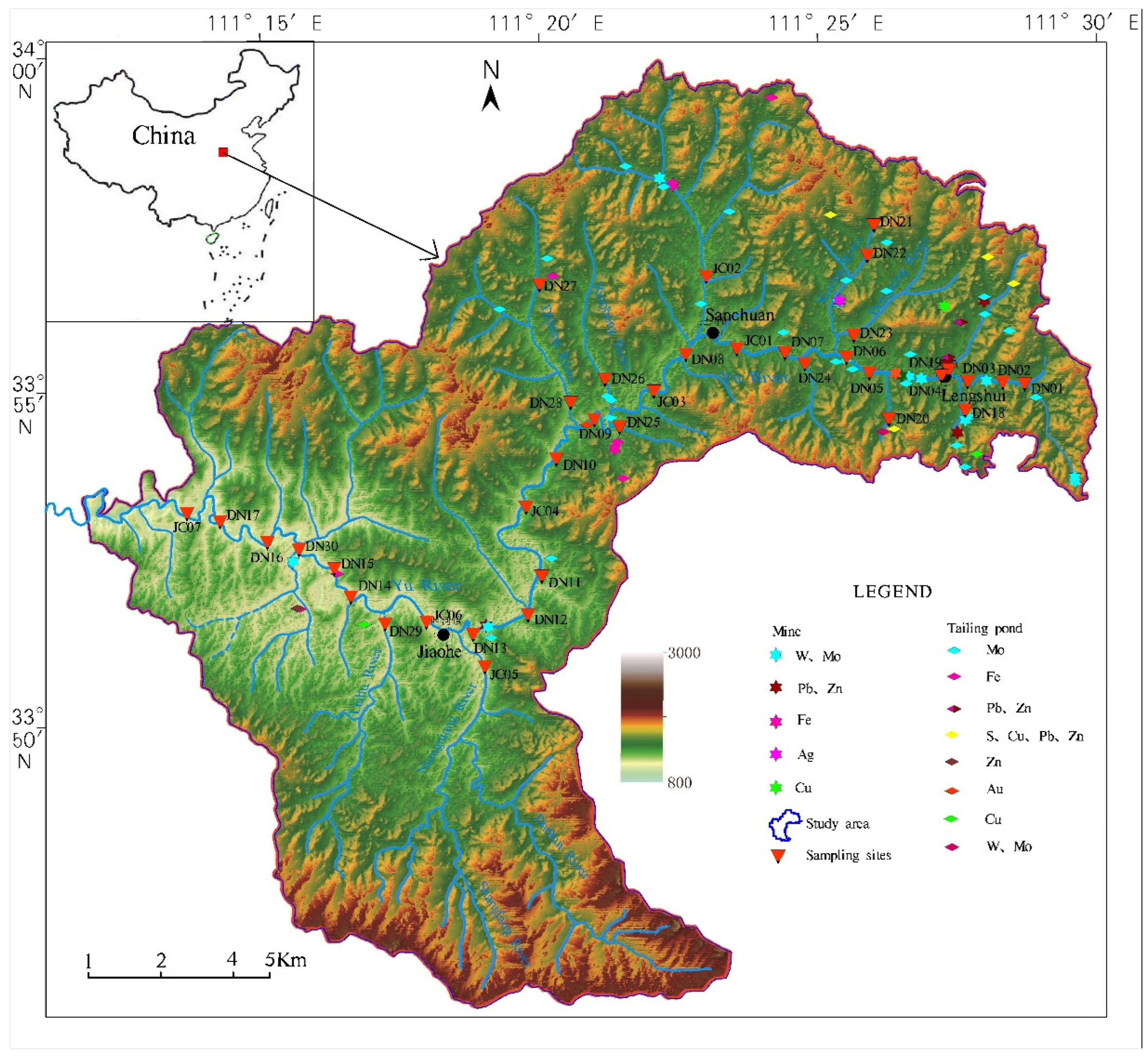
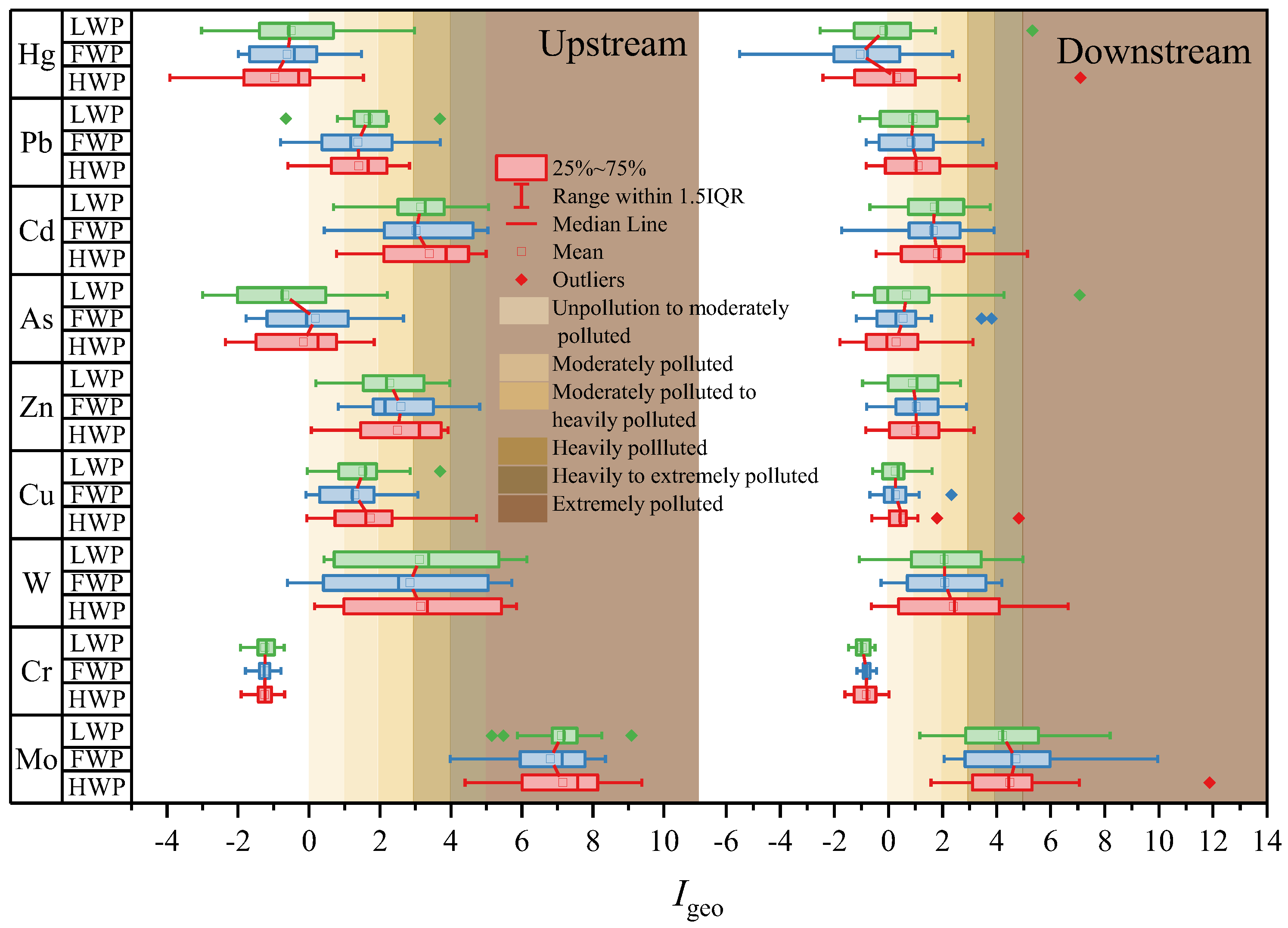

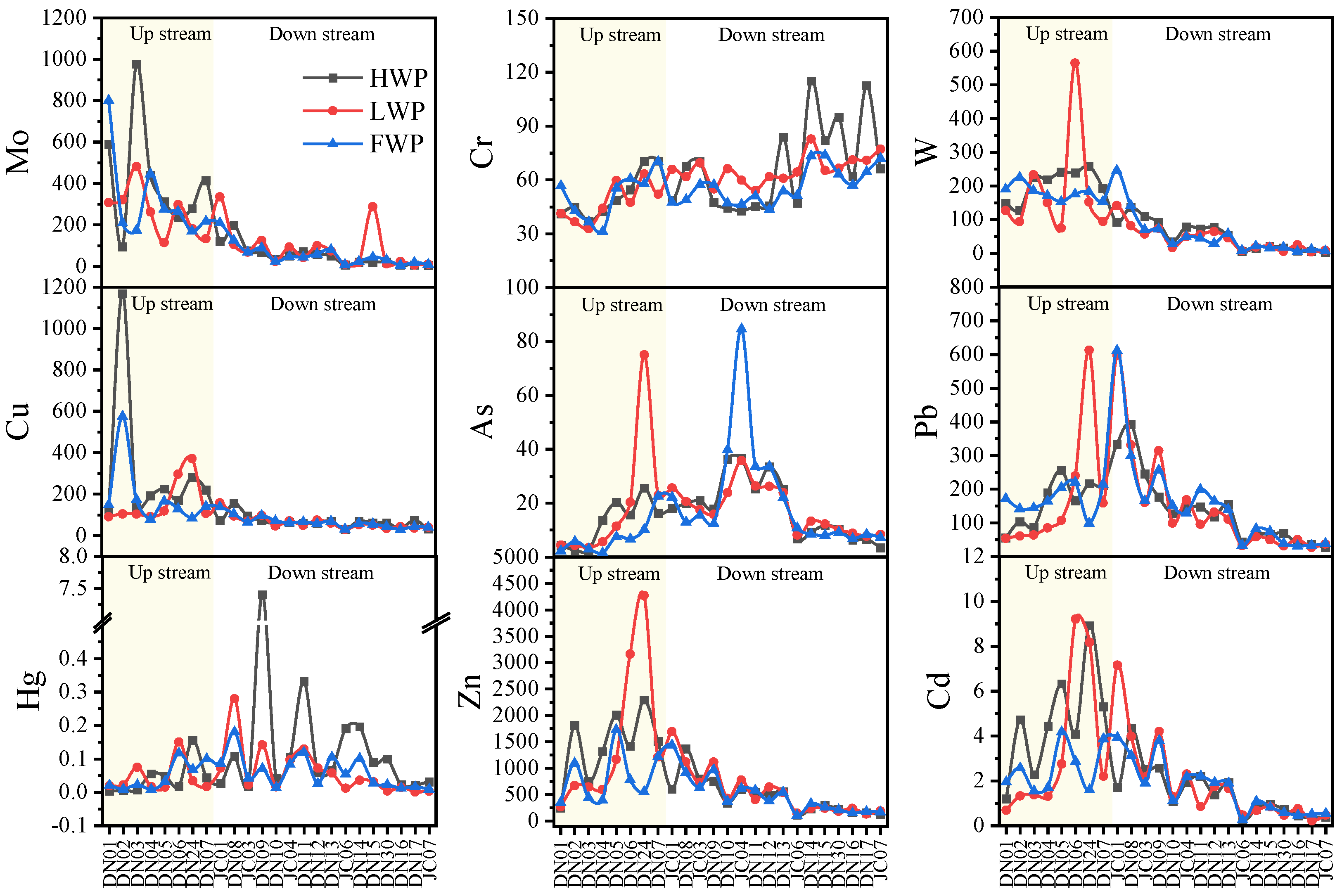
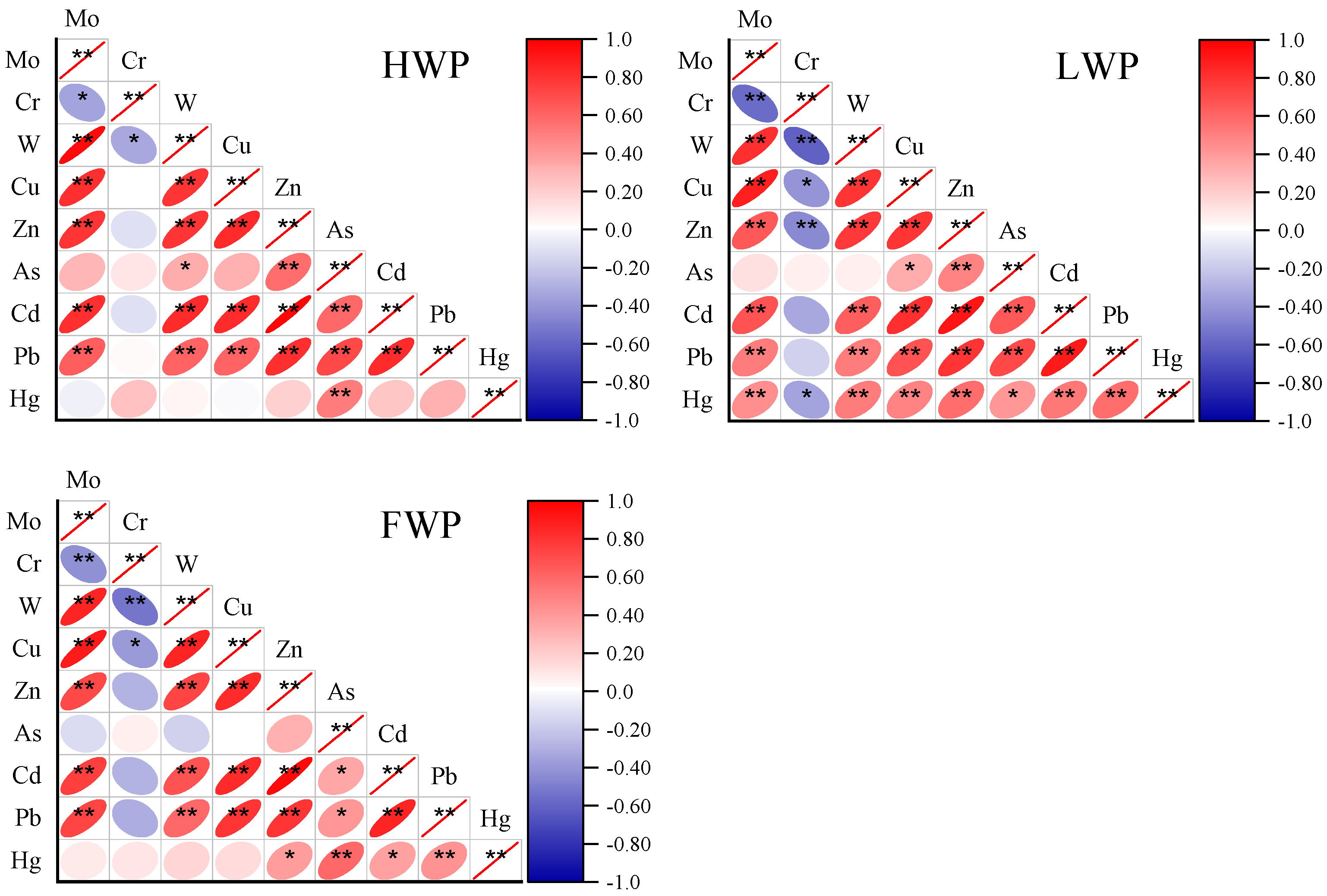
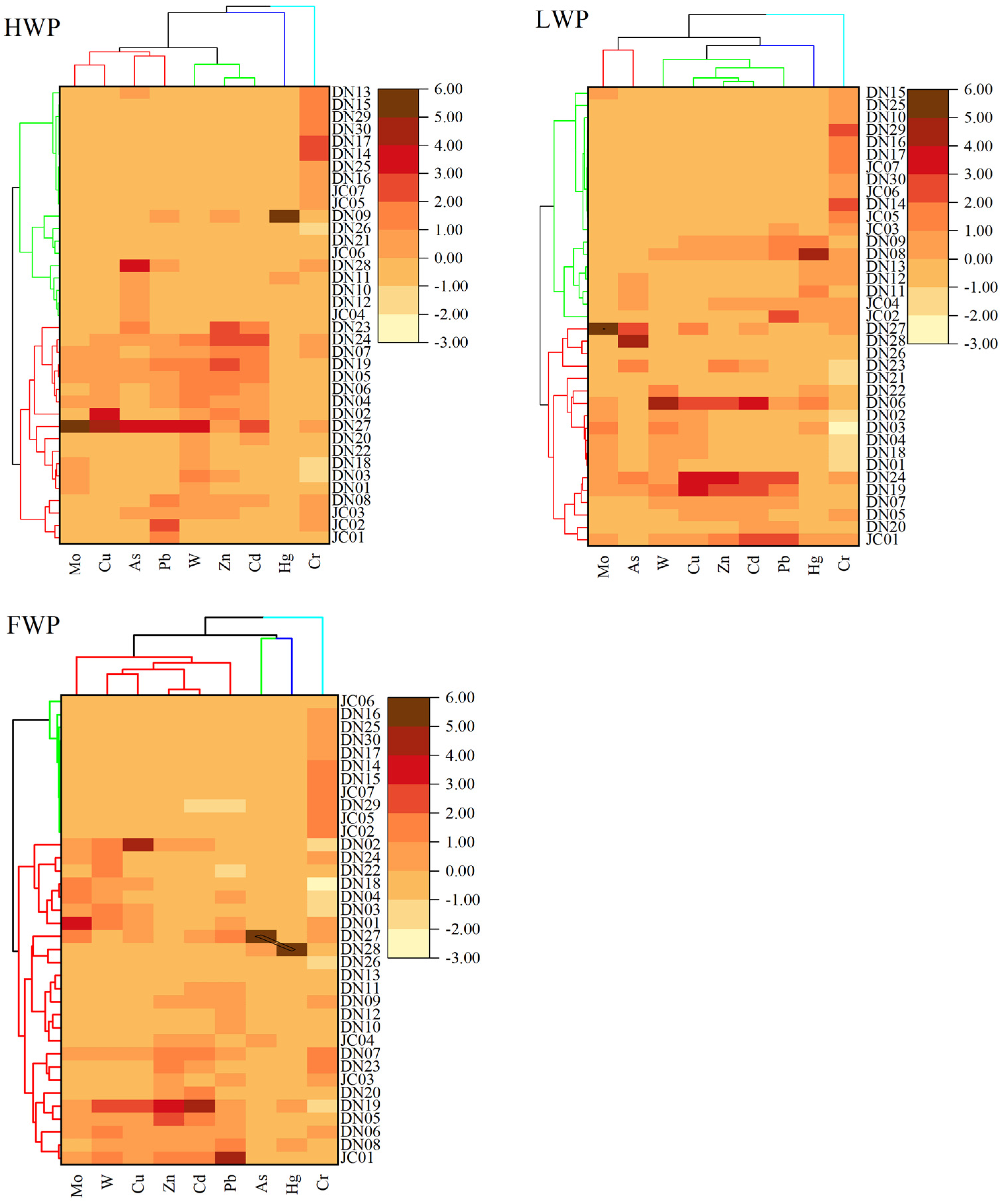
| Sampling Periods | Location | Statistical Values | Mo | Cr | W | Cu | Zn | As | Cd | Pb | Hg |
|---|---|---|---|---|---|---|---|---|---|---|---|
| HWP | Up stream (n = 15) | Min | 31.0 | 30.2 | 28.1 | 42.5 | 159.3 | 2.3 | 0.5 | 31.3 | 0.004 |
| Max | 976.4 | 70.5 | 257.7 | 1168.8 | 2299.0 | 42.4 | 8.9 | 337.2 | 0.157 | ||
| Mean | 295.0 | 49.0 | 167.7 | 218.8 | 1181.4 | 15.1 | 4.0 | 158.1 | 0.042 | ||
| SD | 246.8 | 10.9 | 73.9 | 277.5 | 807.6 | 11.4 | 2.7 | 99.4 | 0.038 | ||
| CV | 0.84 | 0.22 | 0.44 | 1.27 | 0.68 | 0.76 | 0.68 | 0.63 | 0.910 | ||
| Down stream (n = 22) | Min | 4.4 | 37.3 | 2.9 | 29.1 | 84.9 | 3.4 | 0.2 | 26.8 | 0.010 | |
| Max | 5497.6 | 115.1 | 448.0 | 1249.0 | 1366.1 | 104.0 | 9.9 | 747.2 | 7.405 | ||
| Mean | 288.8 | 67.8 | 57.2 | 114.4 | 411.0 | 23.1 | 1.6 | 164.8 | 0.415 | ||
| SD | 1164.2 | 22.1 | 95.6 | 254.9 | 326.2 | 27.2 | 2.1 | 190.7 | 1.563 | ||
| CV | 4.03 | 0.33 | 1.67 | 2.23 | 0.79 | 1.18 | 1.28 | 1.16 | 3.770 | ||
| LWP | Up stream (n = 15) | Min | 23.1 | 32.9 | 24.1 | 41.8 | 268.5 | 3.5 | 0.38 | 27.2 | 0.014 |
| Max | 481.0 | 65.9 | 564.7 | 371.9 | 4273.4 | 75.1 | 9.21 | 613.1 | 0.151 | ||
| Mean | 216.4 | 48.9 | 155.9 | 138.4 | 1318.2 | 23.0 | 3.44 | 188.4 | 0.045 | ||
| SD | 136.6 | 9.2 | 130.6 | 108.8 | 1193.7 | 25.3 | 3.01 | 192.3 | 0.036 | ||
| CV | 0.63 | 0.19 | 0.84 | 0.79 | 0.91 | 1.10 | 0.87 | 1.02 | 0.800 | ||
| Down stream (n = 22) | Min | 6.1 | 50.8 | 3.7 | 27.6 | 87.4 | 5.2 | 0.08 | 26.7 | 0.001 | |
| Max | 1462.7 | 84.0 | 81.6 | 222.2 | 1120.1 | 167.0 | 4.19 | 532.7 | 0.280 | ||
| Mean | 121.4 | 65.3 | 30.2 | 60.3 | 400.2 | 27.7 | 1.32 | 124.0 | 0.052 | ||
| SD | 306.3 | 8.6 | 26.5 | 40.8 | 303.9 | 40.1 | 1.16 | 124.3 | 0.065 | ||
| CV | 2.52 | 0.13 | 0.88 | 0.68 | 0.76 | 1.45 | 0.88 | 1.00 | 1.230 | ||
| FWP | Up stream (n = 15) | Min | 52.2 | 29.8 | 27.1 | 42.9 | 173.6 | 1.5 | 0.45 | 30.2 | 0.007 |
| Max | 800.9 | 70.1 | 315.6 | 575.4 | 2378.3 | 54.9 | 9.32 | 612.1 | 0.422 | ||
| Mean | 257.2 | 49.7 | 174.6 | 160.7 | 935.0 | 12.3 | 3.12 | 183.0 | 0.072 | ||
| SD | 191.5 | 12.7 | 68.5 | 137.1 | 640.7 | 14.2 | 2.20 | 135.7 | 0.107 | ||
| CV | 0.74 | 0.25 | 0.39 | 0.85 | 0.69 | 1.15 | 0.70 | 0.74 | 1.480 | ||
| Down stream (n = 22) | Min | 3.3 | 41.1 | 2.1 | 29.5 | 78.4 | 4.8 | 0.17 | 22.8 | 0.009 | |
| Max | 432.2 | 80.5 | 141.5 | 136.3 | 969.7 | 1600.1 | 3.79 | 365.1 | 2.159 | ||
| Mean | 56.0 | 59.4 | 31.3 | 58.0 | 365.3 | 99.6 | 1.30 | 120.3 | 0.152 | ||
| SD | 90.2 | 11.7 | 33.2 | 26.4 | 258.1 | 338.6 | 1.05 | 93.7 | 0.450 | ||
| CV | 1.61 | 0.20 | 1.06 | 0.46 | 0.71 | 3.40 | 0.81 | 0.78 | 2.970 | ||
| Lom River, Cameroon (Au mine) [11] | 0.3~22.5 | 26~3226 | / | 123~521 | 14.2~556 | 11~111 | 0.17~8.6 | 6~161 | / | ||
| Taojiang River, China (W mine) [29] | / | 7.02~80.4 | 4.42~54.5 | 23.53~55.6 | 44.94~212 | 6.26~27.2 | 0.2~65.8 | 8.33~107.2 | 0.07~6.6 | ||
| Jishui River, China (Pb/Zn mine, Au mine, Cu mine) [14] | / | / | / | 34~3447 | 59~1270 | 12~864 | 0.2~256.9 | 31.6~545.2 | / | ||
| Ganga River, India [30] | / | 7.12~155.0 | / | 2.1~73.89 | 6.3~104.3 | / | 0.21~3.6 | 2.1~36.5 | / | ||
| Tajum River, Indonesia (Au mine) [13] | / | / | / | 87~210 | 83~550 | / | 1.5~6.5 | 34~110 | / | ||
| Background values | 0.98 | 75.8 | 2.99 | 29.6 | 101.4 | 7.92 | 0.187 | 31.6 | 0.036 | ||
| Elements | HWP | LWP | FWP | |||||||||
|---|---|---|---|---|---|---|---|---|---|---|---|---|
| PC1 | PC2 | PC3 | PC4 | PC1 | PC2 | PC3 | PC4 | PC1 | PC2 | PC3 | PC4 | |
| Mo | 0.928 | 0.107 | −0.080 | −0.078 | 0.081 | 0.394 | 0.787 | −0.069 | 0.220 | 0.656 | 0.459 | −0.288 |
| Cr | 0.024 | −0.092 | 0.972 | −0.065 | −0.027 | −0.863 | −0.105 | −0.101 | −0.084 | −0.848 | 0.070 | −0.219 |
| W | 0.565 | 0.616 | −0.332 | −0.068 | 0.615 | 0.674 | −0.123 | 0.109 | 0.635 | 0.663 | −0.095 | −0.147 |
| Cu | 0.660 | 0.435 | −0.073 | −0.127 | 0.879 | 0.230 | 0.315 | −0.053 | 0.598 | 0.462 | −0.013 | −0.126 |
| Zn | 0.066 | 0.980 | −0.053 | 0.025 | 0.955 | 0.128 | 0.038 | 0.075 | 0.968 | 0.093 | −0.021 | 0.021 |
| As | 0.787 | 0.082 | 0.086 | 0.068 | 0.211 | −0.199 | 0.842 | 0.060 | −0.019 | −0.061 | 0.937 | 0.074 |
| Cd | 0.473 | 0.863 | −0.032 | 0.013 | 0.921 | 0.130 | 0.151 | 0.211 | 0.923 | 0.130 | 0.088 | 0.066 |
| Pb | 0.748 | 0.327 | 0.045 | 0.084 | 0.769 | −0.230 | 0.144 | 0.372 | 0.641 | 0.170 | 0.502 | 0.070 |
| Hg | 0.001 | 0.003 | −0.061 | 0.985 | 0.198 | 0.154 | −0.016 | 0.949 | 0.034 | 0.030 | 0.064 | 0.952 |
Disclaimer/Publisher’s Note: The statements, opinions and data contained in all publications are solely those of the individual author(s) and contributor(s) and not of MDPI and/or the editor(s). MDPI and/or the editor(s) disclaim responsibility for any injury to people or property resulting from any ideas, methods, instructions or products referred to in the content. |
© 2024 by the authors. Licensee MDPI, Basel, Switzerland. This article is an open access article distributed under the terms and conditions of the Creative Commons Attribution (CC BY) license (https://creativecommons.org/licenses/by/4.0/).
Share and Cite
Bai, H.; Liu, G.; Chen, D.; Xing, Z.; Wang, Y.; Wang, J.; Zhao, Y. Heavy Metal Pollution in Sediments of the Yu River in a Polymetallic Ore Concentration Area: Temporal–Spatial Variation, Risk Assessment, and Sources Apportionment. Sustainability 2024, 16, 1154. https://doi.org/10.3390/su16031154
Bai H, Liu G, Chen D, Xing Z, Wang Y, Wang J, Zhao Y. Heavy Metal Pollution in Sediments of the Yu River in a Polymetallic Ore Concentration Area: Temporal–Spatial Variation, Risk Assessment, and Sources Apportionment. Sustainability. 2024; 16(3):1154. https://doi.org/10.3390/su16031154
Chicago/Turabian StyleBai, Heling, Guannan Liu, Danli Chen, Zhengsong Xing, Yuhao Wang, Juan Wang, and Yuanyi Zhao. 2024. "Heavy Metal Pollution in Sediments of the Yu River in a Polymetallic Ore Concentration Area: Temporal–Spatial Variation, Risk Assessment, and Sources Apportionment" Sustainability 16, no. 3: 1154. https://doi.org/10.3390/su16031154
APA StyleBai, H., Liu, G., Chen, D., Xing, Z., Wang, Y., Wang, J., & Zhao, Y. (2024). Heavy Metal Pollution in Sediments of the Yu River in a Polymetallic Ore Concentration Area: Temporal–Spatial Variation, Risk Assessment, and Sources Apportionment. Sustainability, 16(3), 1154. https://doi.org/10.3390/su16031154








